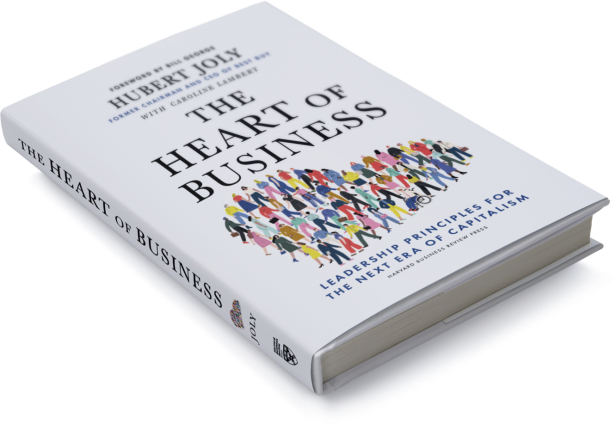L’auteur de From Good to Great propose dans cet ouvrage une réflexion sur la chute des empires et des civilisations. Ou plutôt : sur la chute des grandes entreprises. A quel moment la décadence commence-t-elle ? Comment l’identifier ? Et peut-on l’empêcher avant qu’elle ne prenne des proportions trop importantes ?
Au passage, il propose une de fait au travers des « marqueurs d’étape » en fin de chapitre une intéressante checklist qui permet de vérifier si notre organisation est plutôt en bonne santé ou plutôt sur le déclin. Oserez-vous passer le test ?
Note : j’ai toujours été fasciné par cet ouvrage. Je trouve l’idée intéressante, le titre excellent et ceux qui me connaissent savent que j’ai une adoration quasi mystique pour les ruines des lieux de pouvoirs abandonnés, notamment les vestiges des civilisations disparues. Pour autant, je ne suis pas 100% à l’aise avec son contenu. L’auteur raconte beaucoup d’histoires qui forment un excellent storytelling, mais une base factuelle glissante pour tirer des conclusions. Un exemple : une longue digression sur la montée de l’empereur romain Auguste et la décadence de Rome. Sujet glissant s’il en est ! D’abord, la décadence de l’Empire romain dure quatre siècles ! Et on en connait beaucoup moins qu’on ne voudrait l’admettre. D’autant plus que j’ai quelques doutes quant à la qualité de l’analyse lorsqu’un un auteur de management américain refait l’histoire sur la base d’un cours d’université américaine !!!
La liste ci-dessous est un copié-collé des fins des quatre premiers chapitres du livre. Collectivement, ils forment une « not to do list » intéressante. On pourra discuter certains points et certaines affirmations sont difficiles à évaluer quand on se trouve dans le feu de l’action. Quand est-il sain de se montrer optimiste et quand sombre-t-on dans le déni ? A quel moment communiquer une vision est-il une bonne pratique de management et à quel moment se trouve-t-on dans un exercice de propagande qui est en fait une fuite en avant désespéré pour tenter de faire oublier un présent difficile ? Quand une saine réactivité face aux événements devient-elle une panique frénétique ?
Bref, la liste ci-dessous, tout comme l’ouvrage, est glissante. Mais c’est aussi parce que le sujet lui-même est glissant. Alors, en l’absence de mieux. Commencez par cette réflexion. Un académique et auteur intelligent vous propose de partager ce qu’il a pu rassembler de mieux sur l’arrogance qui mène aux catastrophes. Oserez-vous ignorer ses enseignements ? Ou serait-ce un premier signe d’hubris ?
Stage 1 : Hubris Born of Success
SUCCESS ENTITLEMENT, ARROGANCE: Success is viewed as “deserved,” rather than fortuitous, fleeting, or even hard earned in the face of daunting odds; people begin to believe that success will continue almost no matter what the organization decides to do, or not to do.
NEGLECT OF A PRIMARY FLYWHEEL: Distracted by extraneous threats, adventures, and opportunities, leaders neglect a primary flywheel, failing to renew it with the same creative intensity that made it great in the first place.
“WHAT” REPLACES “WHY”: The rhetoric of success (“ We’re successful because we do these specific things”) replaces understanding and insight (“ We’re successful because we understand why we do these specific things and under what conditions they would no longer work”).
DECLINE IN LEARNING ORIENTATION: Leaders lose the inquisitiveness and learning orientation that mark those truly great individuals who, no matter how successful they become, maintain a learning curve as steep as when they first began their careers.
DISCOUNTING THE ROLE OF LUCK: Instead of acknowledging that luck and fortuitous events might have played a helpful role, people begin to presume that success is due entirely to the superior qualities of the enterprise and its leadership.
Stage 2 : Undisciplined Pursuit of More
UNSUSTAINABLE QUEST FOR GROWTH, CONFUSING BIG WITH GREAT: Success creates pressure for more growth, setting up a vicious cycle of expectations; this strains people, the culture, and systems to the breaking point; unable to deliver consistent tactical excellence, the institution frays at the edges.
UNDISCIPLINED DISCONTINUOUS LEAPS: The enterprise makes dramatic moves that fail at least one of the following three tests: 1. Do they ignite passion and fit with the company’s core values? 2. Can the organization be the best in the world at these activities or in these arenas? 3. Will these activities help drive the organization’s economic or resource engine?
DECLINING PROPORTION OF RIGHT PEOPLE IN KEY SEATS: There is a declining proportion of right people in key seats, because of losing the right people and/ or growing beyond the organization’s ability to get enough people to execute on that growth with excellence (e.g., breaking Packard’s Law).
EASY CASH ERODES COST DISCIPLINE: The organization responds to increasing costs by increasing prices and revenues rather than increasing discipline.
BUREAUCRACY SUBVERTS DISCIPLINE: A system of bureaucratic rules subverts the ethic of freedom and responsibility that marks a culture of discipline; people increasingly think in terms of jobs rather than responsibilities.
PROBLEMATIC SUCCESSION OF POWER: The organization experiences leadership-transition difficulties, be they in the form of poor succession planning, failure to groom excellent leaders from within, political turmoil, bad luck, or an unwise selection of successors.
PERSONAL INTERESTS PLACED ABOVE ORGANIZATIONAL INTERESTS: People in power allocate more for themselves or their constituents—more money, more privileges, more fame, more of the spoils of success—seeking to capitalize as much as possible in the short term, rather than investing primarily in building for greatness decades into the future.
Stage 3 : Denial of Risk and Peril
AMPLIFY THE POSITIVE, DISCOUNT THE NEGATIVE: There is a tendency to discount or explain away negative data rather than presume that something is wrong with the company; leaders highlight and amplify external praise and publicity.
BIG BETS AND BOLD GOALS WITHOUT EMPIRICAL VALIDATION: Leaders set audacious goals and/ or make big bets that aren’t based on accumulated experience, or worse, that fly in the face of the facts.
INCURRING HUGE DOWNSIDE RISK BASED ON AMBIGUOUS DATA: When faced with ambiguous data and decisions that have a potentially severe or catastrophic downside, leaders take a positive view of the data and run the risk of blowing a hole “below the waterline.”
EROSION OF HEALTHY TEAM DYNAMICS: There is a marked decline in the quality and amount of dialogue and debate; there is a shift toward either consensus or dictatorial management rather than a process of argument and disagreement followed by unified commitment to execute decisions.
EXTERNALIZING BLAME: Rather than accept full responsibility for setbacks and failures, leaders point to external factors or other people to affix blame.
OBSESSIVE REORGANIZATIONS: Rather than confront the brutal realities, the enterprise chronically reorganizes; people are increasingly preoccupied with internal politics rather than external conditions.
IMPERIOUS DETACHMENT: Those in power become more imperious and detached; symbols and perks of executive-class status amplify detachment; plush new office buildings may disconnect executives from daily life.
Stage 4: Grasping for Salvation
A SERIES OF SILVER BULLETS: There is a tendency to make dramatic, big moves, such as a “game changing” acquisition or a discontinuous leap into a new strategy or an exciting innovation, in an attempt to quickly catalyze a breakthrough—and then to do it again and again, lurching about from program to program, goal to goal, strategy to strategy, in a pattern of chronic inconsistency.
GRASPING FOR A LEADER-AS-SAVIOR: The board responds to threats and setbacks by searching for a charismatic leader and/ or outside savior.
PANIC AND HASTE: Instead of being calm, deliberate, and disciplined, people exhibit hasty, reactive behavior, bordering on panic.
RADICAL CHANGE AND “REVOLUTION” WITH FANFARE: The language of “revolution” and “radical” change characterizes the new era: New programs! New cultures! New strategies! Leaders engage in hoopla, spending a lot of energy trying to align and “motivate” people, engaging in buzzwords and taglines.
HYPE PRECEDES RESULTS: Instead of setting expectations low—underscoring the duration and difficulty of the turnaround—leaders hype their visions; they “sell the future” to compensate for the lack of current results, initiating a pattern of overpromising and underdelivering.
INITIAL UPSWING FOLLOWED BY DISAPPOINTMENTS: There is an initial burst of positive results, but they do not last; dashed hope follows dashed hope; the organization achieves no buildup, no cumulative momentum.
CONFUSION AND CYNICISM: People cannot easily articulate what the organization stands for; core values have eroded to the point of irrelevance; the organization has become “just another place to work,” a place to get a paycheck; people lose faith in their ability to triumph and prevail. Instead of passionately believing in the organization’s core values and purpose, people become distrustful, regarding visions and values as little more than PR and rhetoric.
CHRONIC RESTRUCTURING AND EROSION OF FINANCIAL STRENGTH: Each failed initiative drains resources; cash flow and financial liquidity begin to decline; the organization undergoes multiple restructurings; options narrow and strategic decisions are increasingly dictated by circumstance. »
Envie de lire autre chose de bien ?







